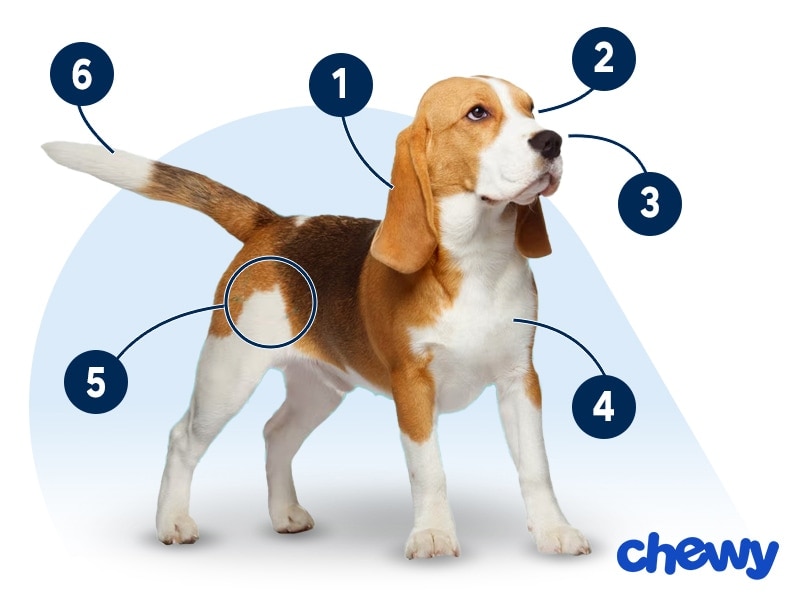Beagle
Updated May 5, 2025
Beagle
Updated May 5, 2025
Beagles are daring pups bursting with energy, but they’re also gentle souls who make excellent family pets. Their keen sense of smell means they’re top-tier candidates for outdoor adventures where they can put their nose to good use—but it also means that Beagles need help from their pet parents so they don’t follow that nose into trouble.
Courageous, Energetic, Friendly
Under 20 pounds
20–30 pounds
Under 13 inches
13–15 inches
10–15 years
Blue Tan and White, Black and Tan, Black Tan and Bluetick, Black Tan and White, Black White and Tan, Brown and White, Brown White and Tan, Lemon and White, Tan and White, Red and White, Black Red and White
These adventurous pups lead with their nose; they’re intelligent, clever, and always go where their sense of smell takes them. (It’s not that your Beagle is ignoring you; they just picked up a whiff of something fascinating in the other direction!)
Beagles are friendly, smart dogs love to have a job to do, so something engaging like scent work or agility trials could be just what they need to be happy. They’ll keep you on your toes, for sure, but it’s worth it for such a cheerful, clever best friend.
And if they howl like a werewolf whenever they miss you? Well, consider it a compliment.
Beagle Characteristics
Beagle Appearance
Beagles are small hound dogs with a short yet muscular stature, a high tail, and floppy ears. They have a gentle, kind gaze that’s the epitome of “puppy dog eyes.”

- Ears
Beagle ears are long and hang low.
- Eyes
Their large eyes are brown or hazel and have a soft, pleading look.
- Nose
A Beagle’s nose ranges in color from light to dark, and they have large nostrils.
- Coat Length
Their coat is close to their skin, dense, and medium in length.
- Coat Color
Beagle colors are tricolor (white, tan, and black), lemon, red, or white. A lemon Beagle (one with a pale yellow coat) is the rarest color.
- Tail
Beagles have a high tail with a slight curve.
Beagle Temperament
Beagles are delightful pups who usually get along well with everyone. They’re determined and adventurous, and their curious nature means they love to play and explore.
Beagle dogs need a lot of exercise and do well when they’re busy; they’re not content to sit around doing nothing. You’ll often see them with their nose to the ground, so an activity like scent work could be just what they need to thrive.
Know that at times, their nose can get the best of them. Your Beagle pup could pick up a scent they just can’t resist and run off after it. So, it’s a good idea to keep them on a leash if you’re somewhere that’s not fenced in.
If you haven’t met your Beagle’s exercise and entertainment quota, they’ll let you know. Their wholly unique “baying” is more intense than a bark but not quite as long as a full howl. Training can help them learn to quiet down, but it’s not it’s not in a Beagle’s temperament to be shy about using their voice.
Keep your pup’s social calendar full with scent work, agility training, or tracking classes, a noncompetitive activity where your dog can use their nose to trace targets.
Like most young dogs, Beagle puppies can be mouthy and chew things they shouldn’t, though most grow out of this by adulthood. Still, training with positive reinforcement can help to curb this tendency.
These social pups make great pets for active families, and they get along well with children. They also do well with other dogs but may need time to adjust to cats. It’s important for Beagles to learn that cats are not something to chase after—it’s an instinct they might hold on to, since Beagles were originally bred as hunting dogs.
How to Care for a Beagle
Raising a Beagle puppy can be a fun and rewarding experience, even if they are a little mischievous at times. Grooming is fairly easy with these pups, but you’ll need to book extra time for training.
Grooming
Training
Diet
Exercise
Environment
Beagle Health
The Beagle lifespan is 10–15 years. Here are some health issues to be aware of so that your Beagle can live as happy and healthy a life as possible.
- Cherry eye: Cherry eye is the common term for prolapse of the gland of the third eyelid. It isn’t usually painful, but it can be irritating for the dog and often requires surgery to fix.
- Dental disease: Beagles tend to experience more dental disease than other dogs their size. Start brushing their teeth when they’re puppies, as dental disease can lead to teeth loss and even more serious issues like heart, liver, and kidney disease.
- Epilepsy: Beagles are prone to seizures caused by epilepsy, a neurological disorder that typically begins in dogs between 6 months and 5 years old. It’s treated with oral medication.
- Hip dysplasia: Hip dysplasia develops during puppyhood when the hip joint doesn’t align well and becomes looser than normal. Signs include limping, and treatment might involve weight loss, reduced activity, joint supplements, physical therapy, pain meds, or, in severe cases, surgery.
- Hypothyroidism: Hypothyroidism is one of the most common endocrine disorders in dogs. It can be diagnosed with a blood test, so thyroid levels should be a normal part of screening blood work as your Beagle ages. Hypothyroidism commonly causes skin infections, ear infections, weight gain, and sluggishness. It can be managed with oral meds.
- Intervertebral disc disease (IVDD): IVDD is a neurological condition caused by a bulging or slipped disc. It can be very painful, and your dog may be suddenly paralyzed or unable to use their back legs. Keeping your Beagle at a healthy weight helps prevent IVDD. You can also set up ramps or stairs so they don’t have to jump on the furniture.
- Luxating patella: Beagles can develop luxating patella, where the kneecap slips out of place. You might notice that they do a little bunny hop or skip while walking—this could be a symptom. It may be treated with supplements and meds, if mild, though surgery may be necessary.
Beagle History
While the breed’s origins aren’t exactly clear, reports of small hounds that hunted hares in Great Britain date back as far as 55 B.C.E. As time went on, larger hounds were bred for tracking down deer, and smaller hounds were bred for rabbit hunting.
Modern Beagles are most likely descendants of smaller hunting hounds from the 1500s. Around that time, Beagles became popular as “foot hounds,” meaning that—unlike with larger hound breeds—one could hunt with a pack of Beagles on foot instead of on horseback.
Beagles arrived in the U.S. after the Civil War, and a Beagle named Blunder was the first to be recognized by the American Kennel Club (AKC) in 1885. Today, Beagles are one of the most popular dog breeds in the U.S.
A Beagle puppy can cost up to $1,500. If you choose this route, pick a responsible breeder.
You can also adopt a Beagle from a Beagle rescue group like Happy Life Beagle Rescue, keep an eye out for the breed at your local animal shelter, or search Chewy’s database of adoptable dogs in your area.
































